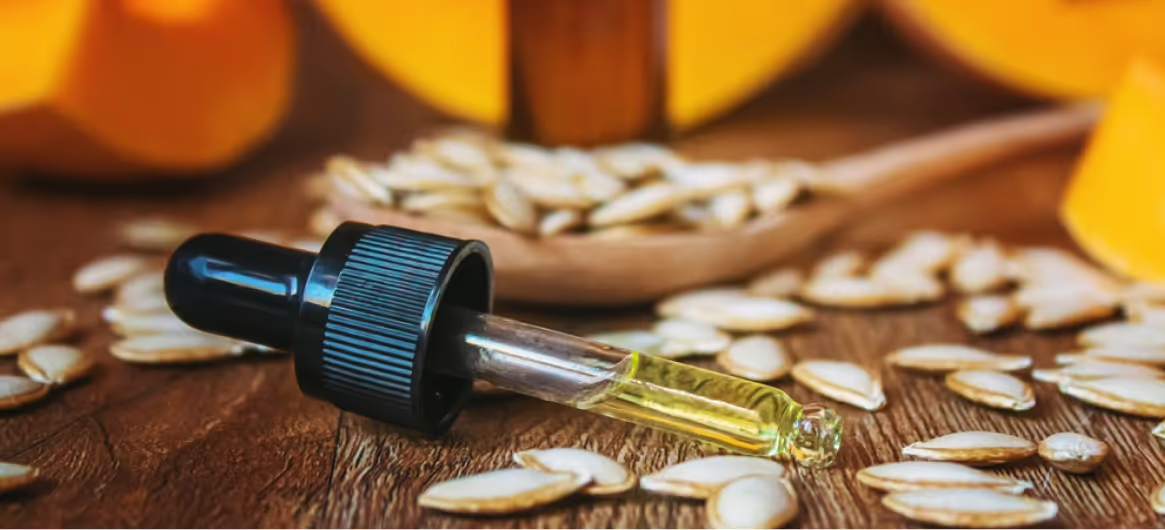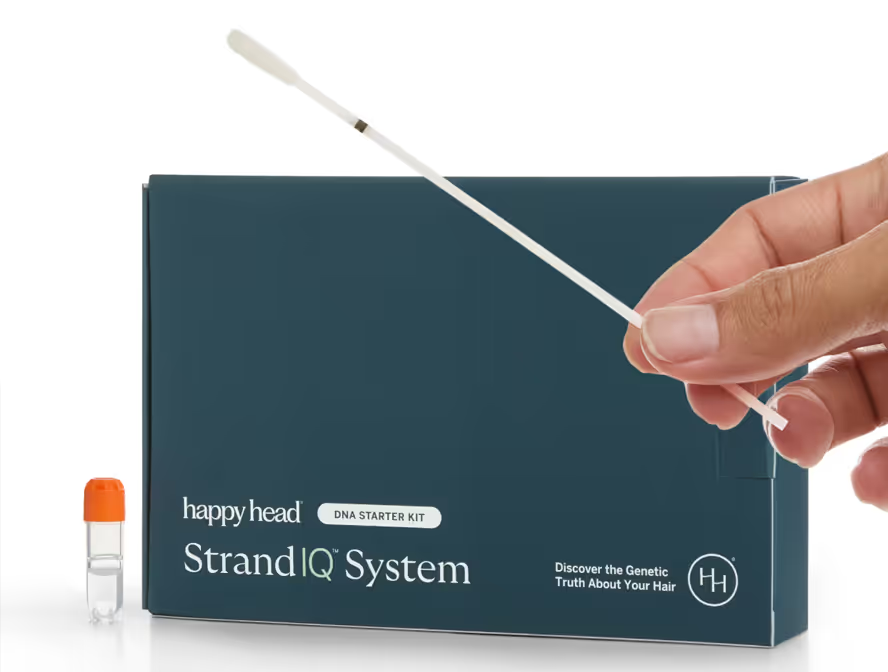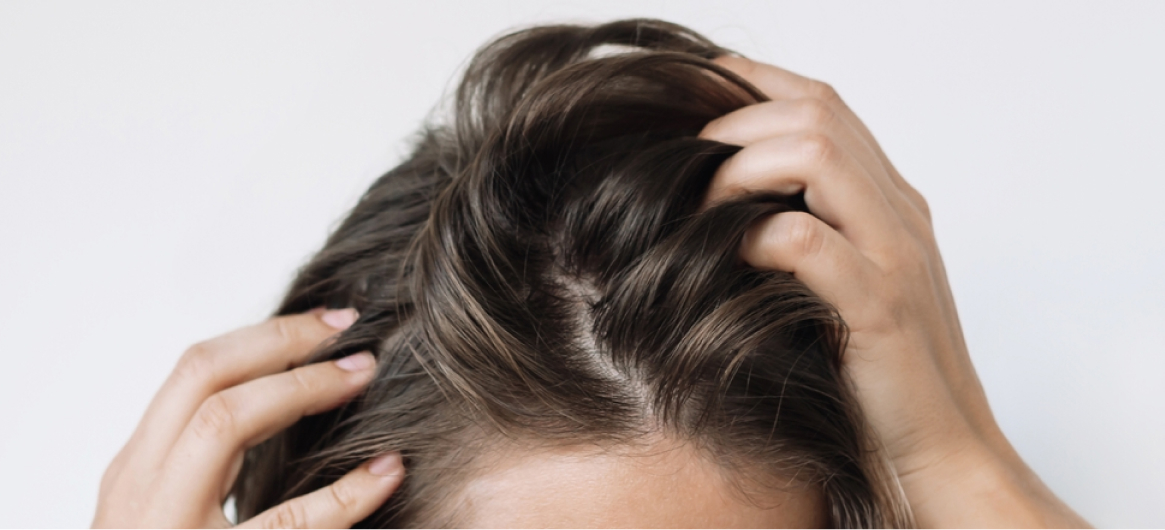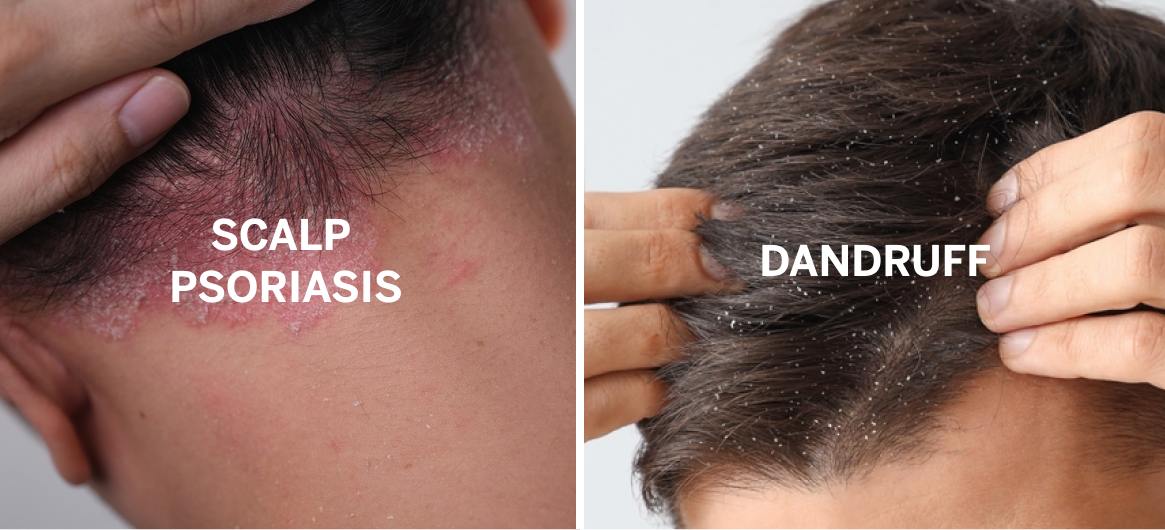Using pumpkin seed oil for hair loss has become an area of growing interest among individuals seeking natural, evidence-informed options to support hair health.
While not a substitute for clinically proven treatments, pumpkin seed oil contains several compounds, such as fatty acids, phytosterols, and antioxidants, that may contribute to a healthier scalp environment and help protect hair follicles.
Let’s explore how pumpkin seed oil works, who may benefit from it, and how to incorporate it safely into a hair loss care plan.
Does Pumpkin Seed Oil Help With Hair Loss?
Pumpkin seed oil has been gaining attention as a potential natural remedy for hair loss, particularly for androgenetic alopecia. While research is still ongoing, it is thought that pumpkin seed oil may influence hair growth by modulating hormones and reducing inflammation.
Rich in bioactive compounds, pumpkin seed oil is believed to impact the underlying mechanisms that contribute to follicle miniaturization and hair shedding.
Though not a replacement for prescription treatments, it may offer supportive benefits, especially for those seeking a more natural approach to hair care.
The Science Behind Pumpkin Seed Oil for Hair Loss
Pumpkin seed oil may support hair health through several overlapping mechanisms. It contains phytosterols, particularly beta-sitosterol, which are believed to naturally inhibit the enzyme 5-alpha-reductase.
This enzyme plays a key role in converting testosterone into dihydrotestosterone (DHT), a hormone associated with hair follicle shrinkage.
By limiting this conversion, pumpkin seed oil may help protect follicles from premature miniaturization. In addition, the oil’s rich concentration of omega-6 and omega-9 fatty acids helps nourish the scalp, support the hair growth cycle, and reduce scalp inflammation.
These nutrients work synergistically to create a healthier scalp environment, which is essential for maintaining strong, resilient hair follicles over time.
How Pumpkin Seed Oil May Affect DHT and Hair Follicles
Dihydrotestosterone (DHT) binds to receptors in hair follicles and contributes to their gradual shrinking—a process called follicular miniaturization. This leads to shorter growth cycles and finer hair strands, eventually resulting in hair thinning or baldness.
Pumpkin seed oil contains phytosterols such as beta-sitosterol, which are believed to naturally inhibit the enzyme 5-alpha-reductase.
By limiting this enzyme’s activity, pumpkin seed oil may reduce DHT levels in the scalp and allow hair follicles to remain in the anagen (growth) phase longer.
Unlike pharmaceutical DHT blockers, pumpkin seed oil may offer a gentler approach with fewer reported side effects, though more research is needed to establish its comparative potency and consistency.
Key Nutrients in Pumpkin Seed Oil That Support Hair Health
Pumpkin seed oil is more than just a trendy natural remedy—it’s a nutrient-dense oil packed with compounds that can directly and indirectly support healthy hair.
Its unique combination of fatty acids, antioxidants, vitamins, and plant sterols makes it especially relevant for those seeking to improve scalp health and strengthen hair from the root.
Each of these components plays a distinct role, whether it's nourishing hair follicles, maintaining the integrity of the scalp barrier, or counteracting the effects of environmental stressors.
Fatty Acids and Their Role in Hair Growth
Pumpkin seed oil is rich in essential fatty acids, particularly linoleic acid (omega-6) and oleic acid (omega-9), which contribute to healthier hair and scalp.
Linoleic acid helps reinforce the skin’s barrier function, reducing transepidermal water loss and improving scalp hydration—both of which are essential for strong, well-moisturized hair. Oleic acid promotes better absorption of nutrients into the skin and may help soothe inflammation.
These fatty acids also support the anagen (growth) phase of the hair cycle by maintaining follicular health and reducing oxidative stress around the root.
Regular exposure to these lipids can improve hair texture, reduce brittleness, and create an optimal environment for sustained hair growth.
Antioxidants, Vitamin E, and Other Beneficial Compounds
Pumpkin seed oil contains a powerful blend of antioxidants that help protect hair follicles from damage caused by oxidative stress, a common contributor to hair thinning.
Vitamin E, one of the oil’s most abundant antioxidants, supports circulation in the scalp and helps neutralize free radicals that can disrupt follicle function. The oil also provides carotenoids, selenium, and zinc, all of which are involved in cellular repair and immune regulation.
Together, these compounds may help extend the growth phase of the hair cycle while minimizing breakage and scalp inflammation.
By defending against environmental and metabolic stressors, these nutrients work in harmony to preserve healthy hair density and support long-term scalp vitality.
Who Should Consider Pumpkin Seed Oil for Hair Loss?
Pumpkin seed oil may be worth considering for individuals experiencing mild to moderate hair thinning, especially those with androgenetic alopecia, or pattern baldness.
It’s often chosen by people seeking a plant-based, natural approach to hair loss without the hormonal side effects sometimes associated with prescription treatments.
Because it offers both topical and oral use options, it appeals to a wide range of users. It may also be beneficial for those looking to improve overall scalp health as a foundation for better hair growth.
Is Pumpkin Seed Oil Safe for Everyone?
Pumpkin seed oil is generally well-tolerated by most people when used appropriately, but it may not be suitable for everyone. Those with allergies to pumpkin or other seeds should avoid it.
Additionally, people with hormone-sensitive conditions or who are taking medications that alter hormonal activity should consult a doctor before using pumpkin seed oil, as it may influence levels of DHT.
Pregnant or breastfeeding women should also seek medical guidance, as the effects in these populations are not fully studied.
While topical use is considered low risk, oral supplements can interact with certain medications, including anticoagulants. As with any hair loss remedy, it’s essential to use pumpkin seed oil under medical supervision when addressing an underlying medical condition.
Possible Side Effects and Precautions
Although side effects from pumpkin seed oil are uncommon, they can occur in some individuals. Oral use may lead to mild gastrointestinal symptoms such as bloating, stomach cramps, or diarrhea, especially when taken in large doses.
Allergic reactions, though rare, can include itching, rash, or swelling, particularly with topical application. To minimize risk, a patch test is recommended before applying pumpkin seed oil directly to the scalp.
People taking blood thinners or hormonal therapies should use caution, as the oil’s phytosterols may interfere with these medications.
Always choose a high-quality, cold-pressed oil to avoid contamination and ensure the highest therapeutic value. Consulting a dermatologist or healthcare provider before beginning regular use is strongly advised.
How To Use Pumpkin Seed Oil for Hair Loss
Pumpkin seed oil can be used both topically and orally to support hair health, giving users flexibility based on their preferences and goals. Choosing the right method—and using it consistently—is key to seeing results.

Oral Supplements vs. Topical Application
Pumpkin seed oil can be taken orally in softgel or liquid form or applied directly to the scalp.
Oral supplements are often chosen for their convenience and systemic action. They deliver nutrients internally, which may help regulate DHT levels and support overall hair and scalp health.
Capsules typically provide a concentrated dose of cold-pressed oil and are taken once or twice daily with meals.
Topical application targets the scalp directly. Users massage the oil into the scalp and leave it on for 20–30 minutes—or overnight—before rinsing. This method may help improve local circulation, reduce scalp inflammation, and support follicular health.
Some people combine both approaches for a more comprehensive routine, but it’s best to consult a dermatologist before doing so.
Recommended Dosage and Application Methods
For oral use, a common dosage of pumpkin seed oil is 1,000 to 2,000 mg per day, often divided into two doses. However, dosing can vary by product, so it’s important to follow the manufacturer’s guidelines or seek medical advice.
Consistency is important, and results typically appear after 8 to 12 weeks of regular use.
For topical application, use a small amount—typically 1 to 2 teaspoons—massaged gently into the scalp. Some users add essential oils such as rosemary or peppermint for added benefits, but this should be done cautiously and only with proper dilution.
The oil can be used as a pre-shampoo scalp treatment two to three times per week. Always perform a patch test before first use to avoid skin irritation or allergic reactions.
What To Expect When Using Pumpkin Seed Oil for Hair Loss
When starting pumpkin seed oil as a topical treatment, users may notice some greasiness on the scalp or hair. To avoid buildup, it’s best to use it as a pre-wash treatment.
With both oral and topical pumpkin seed oil, some individuals may also experience mild initial shedding, which can occur as older hairs are pushed out to make way for new growth. This is temporary and usually resolves within a few weeks.
As with most natural treatments, results are gradual and require consistent use over time.
How Long Does It Take to See Results?
Pumpkin seed oil is not a quick fix—visible improvements typically take 8 to 12 weeks of consistent use, and more substantial changes may require 4 to 6 months or longer.
Early signs that the oil is working may include reduced hair shedding, improved scalp comfort, and the emergence of fine “baby hairs” along the hairline or part.
Thicker, stronger regrowth may follow over time, especially if used alongside other hair-supportive habits or proven prescription treatments. Patience and consistency are essential.
Comparing Pumpkin Seed Oil With Other Hair Loss Treatments
While pumpkin seed oil shows potential for supporting hair health, it's important to understand how it compares with established treatments. Each option works differently, and effectiveness can vary based on the underlying cause of hair loss.
Pumpkin Seed Oil vs. Minoxidil
Minoxidil is an FDA-approved topical treatment (though it is also available orally by prescription) that works by widening blood vessels and stimulating hair follicles, often prolonging the growth phase.
It's widely studied and clinically proven but may cause side effects such as scalp irritation or unwanted facial hair growth in some users.
Pumpkin seed oil, by contrast, works indirectly by nourishing the scalp and possibly reducing DHT levels. While not as fast-acting or potent as minoxidil, it’s often better tolerated by those seeking a gentler, natural alternative.
Some individuals use both together for complementary benefits, though this should be done with professional guidance.
Pumpkin Seed Oil vs. Finasteride

Finasteride is a prescription medication available in oral and topical forms that inhibits the enzyme 5-alpha-reductase, effectively reducing DHT levels in the body.
It’s highly effective for many men with androgenetic alopecia but may cause systemic side effects such as reduced libido or mood changes.
Pumpkin seed oil also contains natural compounds that may inhibit 5-alpha-reductase, but its effect is milder and more localized.
For those who prefer to avoid prescription medications or who experience side effects from finasteride, pumpkin seed oil may offer a less aggressive alternative. However, it may not produce comparable results in cases of advanced hair loss.
Can Pumpkin Seed Oil Be Combined With Other Treatments?
Yes, pumpkin seed oil can often be combined with other treatments, including minoxidil, low-level laser therapy, and even finasteride, under medical supervision.
When used topically, it may enhance scalp health and improve absorption of other active ingredients. Orally, it may provide nutritional support while targeting DHT through a different, gentler pathway.
Combining therapies can potentially lead to better outcomes, especially when hair loss is caused by multiple factors. However, it’s important to avoid product overlap or ingredient interactions and to monitor for side effects.
A dermatologist can help create a safe, effective treatment plan tailored to your needs.
Should You Try Pumpkin Seed Oil for Hair Loss?
Pumpkin seed oil may be a worthwhile option for those experiencing mild to moderate hair thinning and looking for a natural, well-tolerated alternative to conventional treatments.
While results may take time, its nutrient profile and potential DHT-inhibiting effects make it a promising addition to a comprehensive hair care routine.
It’s best suited for people who prefer a gradual, supportive approach and are willing to be consistent. If you're considering new treatment options, speak with a dermatologist about whether pumpkin seed oil for hair loss is right for you.
Talk to a board-certified dermatologist to discuss your goals and find the solution that is best for you.
Frequently Asked Questions
Is pumpkin seed oil good for hair loss?
Pumpkin seed oil may help with hair loss due to its rich content of phytosterols, fatty acids, and antioxidants. These compounds are believed to reduce inflammation, support scalp health, and possibly inhibit DHT, a hormone linked to androgenetic alopecia.
How much pumpkin seed oil should I take for hair loss?
Generally speaking, 400–1,000 mg of pumpkin seed oil extract in capsule form per day is enough to support hair growth. However, dosage can vary based on formulation and individual needs, so it's best to consult a dermatologist before starting supplementation.
How often should I use pumpkin seed oil for hair?
Topical pumpkin seed oil can be used 2 to 3 times per week as a scalp treatment. When taken orally, follow product instructions or consult a dermatologist for specific dosage instructions. Consistency is key, and results may take several months with either method.
How long does it take to see hair growth with pumpkin seed oil?
Visible hair growth results from pumpkin seed oil may take 3 to 6 months or longer with consistent use. This varies based on the individual’s underlying hair loss cause, method of use, and whether pumpkin seed oil is used alone or with other treatments.










